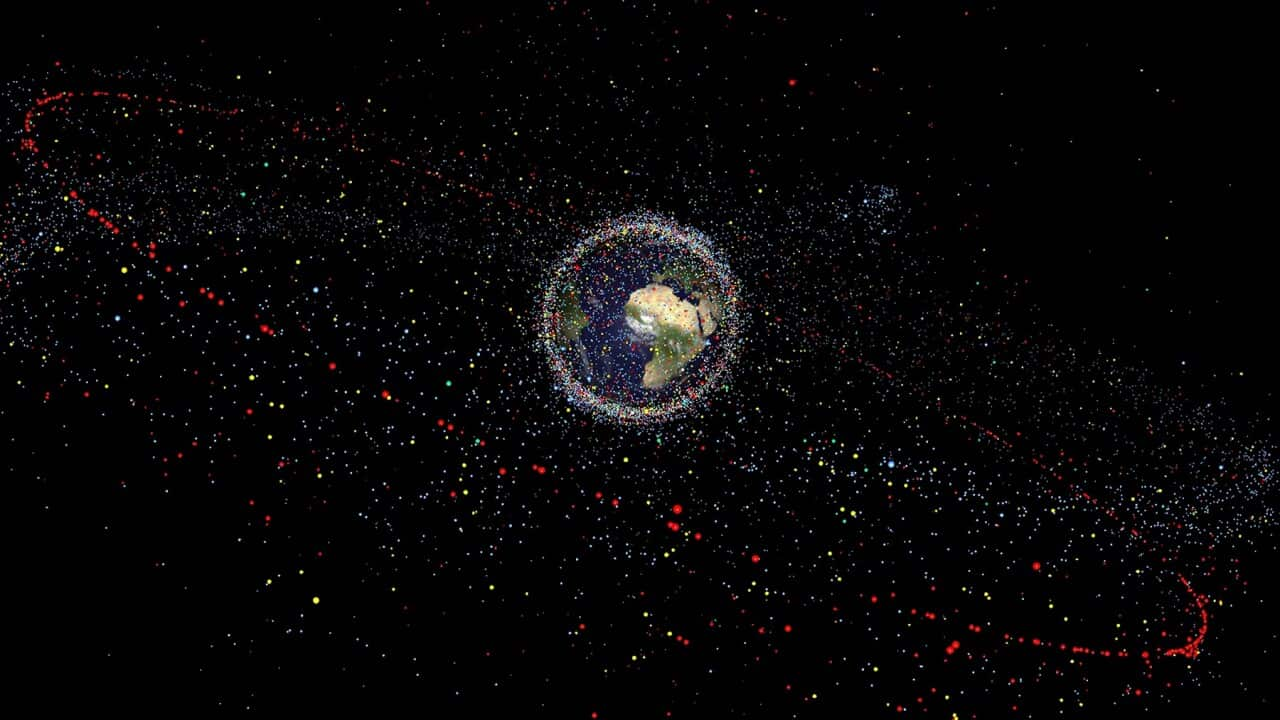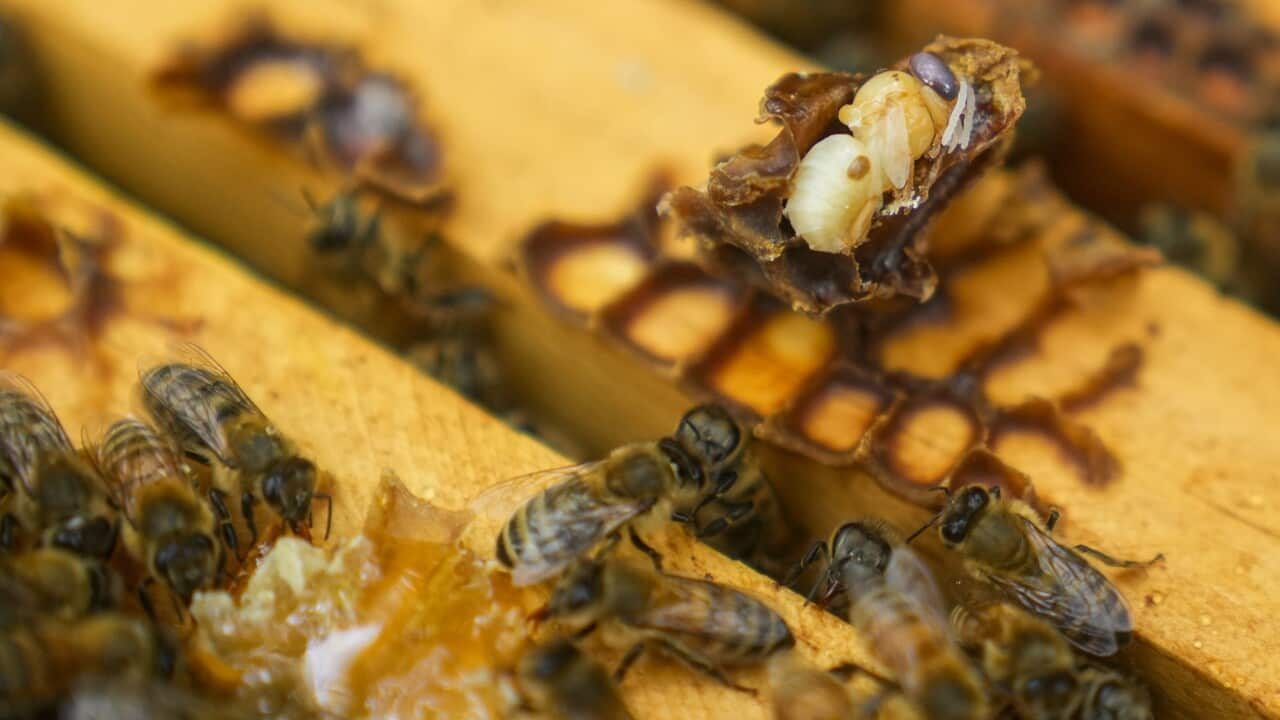Non si vede correttamente? Prova con questo link
SCARICA la trascrizione col testo a fronte in inglese.
Italian
Generazione dopo generazione, lo spazio oltre la Terra è mutato da concetto estremamente lontano a proposta commerciale per alcuni dei paese e delle persone più ricche del mondo.
Nuove opportunità hanno visto il lancio di oltre 6000 oggetti nello spazio - ma hanno anche creato una catastrofe potenziale, secondo Rolf Densing, il direttore delle operazioni della Agenzia Spaziale Europea.
"We are living in a time where companies, businesspeople, are planning to launch mega-constellations. So, as I said, we have about 5,800 satellites in orbit. And then there are people like Elon Musk wanting to launch thousands of satellites as part of a bigger constellation. So, it could well happen that in a matter of no time, the population of satellites in orbits will multiply, and we need to find ways and means to cope with it."
Lo scenario da incubo, secondo gli astronomi, sarebbe un ingorgo stradale su scala cosmica.
Satelliti e altri oggetti potrebbero scontrarsi e creare una catena di tamponamenti.
Questo scenario è stato chiamato la sindrome di Kessler - nominato in onore dello scienziato della NASA che per primo allertò i governo del fenomeno 40 anni fa.
Secondo la teoria, un evento di queste proporzioni potrebbe rendere l'orbita terrestre inutilizzabile per generazioni.
Jan Woerner, direttore generale dell'Agenzia Spaziale Europea, ha paragonato il possibile scenario futuro ad un film catastrofico.
"We have approximately more than one million of pieces, smaller pieces, one centimetre or something like that, flying around the Earth, and the movie Gravity is more science fiction, but it is fiction. We had also a hit of our satellite Sentinel One, which was hit by a tiny part, we saw it also with the launch of Alexander Gerst. His Soyuz capsule was hit by a small piece. So, these small pieces are already one danger. But the other danger comes from bigger parts, parts like old satellites, upper stages, also like adaptors, and this is what we are looking at today. So therefore, this is a very special issue in space, and as space is now an infrastructure, we have to keep our infrastructure clean."
Per affrontare la questione, l'Agenzia Spaziale Europea vuole lanciare la prima missione di sempre nel 2025 per ripulire dai detriti spaziali.
Una start-up svizzera chiamata Clearspace S-A ha creato Clearspace one, una tecnologia che si serve di una navetta spaziale costuita appositamente per catturare e smantellare oggetti.
Tali oggetti includono parti dei propellenti usati per lanciare i satelliti che poi vanno alla deriva nello spazio senza uso - alcuni dei quali pesano fino a 100 chilogrammi.
Muriel Richard-Noca è la co-fondatrice della start-uo ClearSpace S-A.
Definisce la tecnogia complessa.
"We saw that the tentacle was the safest way of going. So, this is a technology that requires the deployment of four arms. At the same time, we are putting a lot of care into the joints and the actuators that will be used for it. And this is something which you can replicate. So, if you throw a net, and the net misses your target, it's too bad, you would have to have a second net and try again. But then you would have to capture not only the net that you launched, but also the target. So, it becomes complicated. Here with the tentacle, if we see that there is a problem, we start going into the capture. We see there is a problem, we can go back, rehearse the whole and verify, and rehearse the whole procedure."
L'Agenzia Spaziale Europea stima che più di 70 oggetti ogni anno entrano nella rotazione della Terra.
I creatori di Clearspace one sostengono che ognuno di essi richieda interventi di manutenzione o debba venire distrutto, e questa nuova tecnologia renderà questi servizi più economici e incoraggerà manutenzione più regolare dei satelliti e di altri oggetti.
Il direttore di Clearspace S-A Luc Piguet è convinto che la tecnologia possa essere alla base di una nuova industria, oltre la terra.
"The idea is to go to larger objects, but mostly to go to multi object removal, to be able to essentially bring down the cost of space operations for that kind of operations. The same technology we're actually demonstrating during this mission have a lot of different applications in orbit, like refuelling satellites, servicing or extending the working life of satellites in orbit, which today is a market that is very little served."
English
Over generations, the space beyond Earth has evolved from a far-away concept to a business proposition for some of the world's most wealthy countries and people.
New opportunities have seen over 6,000 objects launched into space - but have also created a potential catastrophe, according to Rolf Densing, the Director of Operations for the European Space Agency.
"We are living in a time where companies, businesspeople, are planning to launch mega-constellations. So, as I said, we have about 5,800 satellites in orbit. And then there are people like Elon Musk wanting to launch thousands of satellites as part of a bigger constellation. So, it could well happen that in a matter of no time, the population of satellites in orbits will multiply, and we need to find ways and means to cope with it."
The nightmare scenario, according to astronomers, would be like a traffic jam on an cosmic scale.
Satellites and other objects could collide and create a chain of crashes.
Such a scenario is called the Kessler syndrome - named after the NASA scientist who first warned governments about the phenomenon 40 years ago.
According to the theory, an event on that scale could make the Earth's orbit unusable for generations.
Jan Woerner, Director-General of the European Space Agency, likened the possible future scenario to a disaster movie.
"We have approximately more than one million of pieces, smaller pieces, one centimetre or something like that, flying around the Earth, and the movie Gravity is more science fiction, but it is fiction. We had also a hit of our satellite Sentinel One, which was hit by a tiny part, we saw it also with the launch of Alexander Gerst. His Soyuz capsule was hit by a small piece. So, these small pieces are already one danger. But the other danger comes from bigger parts, parts like old satellites, upper stages, also like adaptors, and this is what we are looking at today. So therefore, this is a very special issue in space, and as space is now an infrastructure, we have to keep our infrastructure clean."
To address that issue, The European Space Agency is launching its first-ever space debris clean-up mission in 2025.
A Swiss start-up named Clearspace S-A has created Clearspace one, a technology which uses a custom-made spacecraft to capture and bring down objects.
Such objects include parts of rockets that are used to launch satellites and then drift in space without use - many weigh upwards of 100 kilograms.
Muriel Richard-Noca is co-founder of the ClearSpace S-A start-up.
She describes the technology as complex.
"We saw that the tentacle was the safest way of going. So, this is a technology that requires the deployment of four arms. At the same time, we are putting a lot of care into the joints and the actuators that will be used for it. And this is something which you can replicate. So, if you throw a net, and the net misses your target, it's too bad, you would have to have a second net and try again. But then you would have to capture not only the net that you launched, but also the target. So, it becomes complicated. Here with the tentacle, if we see that there is a problem, we start going into the capture. We see there is a problem, we can go back, rehearse the whole and verify, and rehearse the whole procedure."
The European Space Agency estimates more than 70 objects enter the Earth's rotation each year.
Clearspace one's creators say each requires maintenance or destruction, and this new technology will make those services more affordable and encourage more regular maintenance of satellites and other objects.
Clearspace S-A's Chief Executive Officer Luc Piguet believes the technology could underpin a new industry, beyond Earth.
"The idea is to go to larger objects, but mostly to go to multi object removal, to be able to essentially bring down the cost of space operations for that kind of operations. The same technology we're actually demonstrating during this mission have a lot of different applications in orbit, like refuelling satellites, servicing or extending the working life of satellites in orbit, which today is a market that is very little served."
Report by Camille Bianchi




